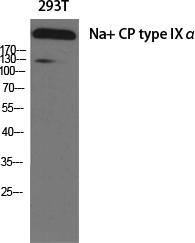Na+ CP type IXα Polyclonal Antibody
- Catalog No.:YT2967
- Applications:WB;IHC;IF;ELISA
- Reactivity:Human;Mouse;Rat
- Target:
- Na+ CP type IXα
- Fields:
- >>Taste transduction
- Gene Name:
- SCN9A
- Protein Name:
- Sodium channel protein type 9 subunit alpha
- Human Gene Id:
- 6335
- Human Swiss Prot No:
- Q15858
- Mouse Swiss Prot No:
- Q62205
- Rat Gene Id:
- 78956
- Rat Swiss Prot No:
- O08562
- Immunogen:
- The antiserum was produced against synthesized peptide derived from human SCN9A. AA range:651-700
- Specificity:
- Na+ CP type IXα Polyclonal Antibody detects endogenous levels of Na+ CP type IXα protein.
- Formulation:
- Liquid in PBS containing 50% glycerol, 0.5% BSA and 0.02% sodium azide.
- Source:
- Polyclonal, Rabbit,IgG
- Dilution:
- WB 1:500 - 1:2000. IHC 1:100 - 1:300. ELISA: 1:40000.. IF 1:50-200
- Purification:
- The antibody was affinity-purified from rabbit antiserum by affinity-chromatography using epitope-specific immunogen.
- Concentration:
- 1 mg/ml
- Storage Stability:
- -15°C to -25°C/1 year(Do not lower than -25°C)
- Other Name:
- SCN9A;NENA;Sodium channel protein type 9 subunit alpha;Neuroendocrine sodium channel;hNE-Na;Peripheral sodium channel 1;PN1;Sodium channel protein type IX subunit alpha;Voltage-gated sodium channel subunit alpha Nav1.7
- Observed Band(KD):
- 220kD
- Background:
- This gene encodes a voltage-gated sodium channel which plays a significant role in nociception signaling. Mutations in this gene have been associated with primary erythermalgia, channelopathy-associated insensitivity to pain, and paroxysmal extreme pain disorder. [provided by RefSeq, Aug 2009],
- Function:
- disease:Defects in SCN9A are a cause of paroxysmal extreme pain disorder (PEPD) [MIM:167400]; previously known as familial rectal pain (FRP). PEPD is an autosomal dominant paroxysmal disorder of pain and autonomic dysfunction. The distinctive features are paroxysmal episodes of burning pain in the rectal, ocular, and mandibular areas accompanied by autonomic manifestations such as skin flushing.,disease:Defects in SCN9A are the cause of autosomal recessive congenital indifference to pain [MIM:243000]; also known as channelopathy-associated insensitivity to pain. Affected individuals have a congenital inability to perceive any form of pain, in any part of the body. All other sensory modalities are preserved and the peripheral and central nervous systems are apparently intact. Patients perceive the sensations of touch, warm and cold temperature, proprioception, tickle and pressure, but not
- Subcellular Location:
- Cell membrane ; Multi-pass membrane protein . Cell projection, neuron projection . In neurite terminals. .
- Expression:
- Expressed strongly in dorsal root ganglion, with only minor levels elsewhere in the body, smooth muscle cells, MTC cell line and C-cell carcinoma. Also expressed in vagus nerves within the head and neck region (PubMed:31647222). Isoform 1 is expressed preferentially in the central and peripheral nervous system. Isoform 2 is expressed preferentially in the dorsal root ganglion.
- June 19-2018
- WESTERN IMMUNOBLOTTING PROTOCOL
- June 19-2018
- IMMUNOHISTOCHEMISTRY-PARAFFIN PROTOCOL
- June 19-2018
- IMMUNOFLUORESCENCE PROTOCOL
- September 08-2020
- FLOW-CYTOMEYRT-PROTOCOL
- May 20-2022
- Cell-Based ELISA│解您多样本WB检测之困扰
- July 13-2018
- CELL-BASED-ELISA-PROTOCOL-FOR-ACETYL-PROTEIN
- July 13-2018
- CELL-BASED-ELISA-PROTOCOL-FOR-PHOSPHO-PROTEIN
- July 13-2018
- Antibody-FAQs
- Products Images

- Western Blot analysis of various cells using Na+ CP type IXα Polyclonal Antibody diluted at 1:1000

- Immunohistochemistry analysis of paraffin-embedded human lung carcinoma tissue, using SCN9A Antibody. The picture on the right is blocked with the synthesized peptide.



